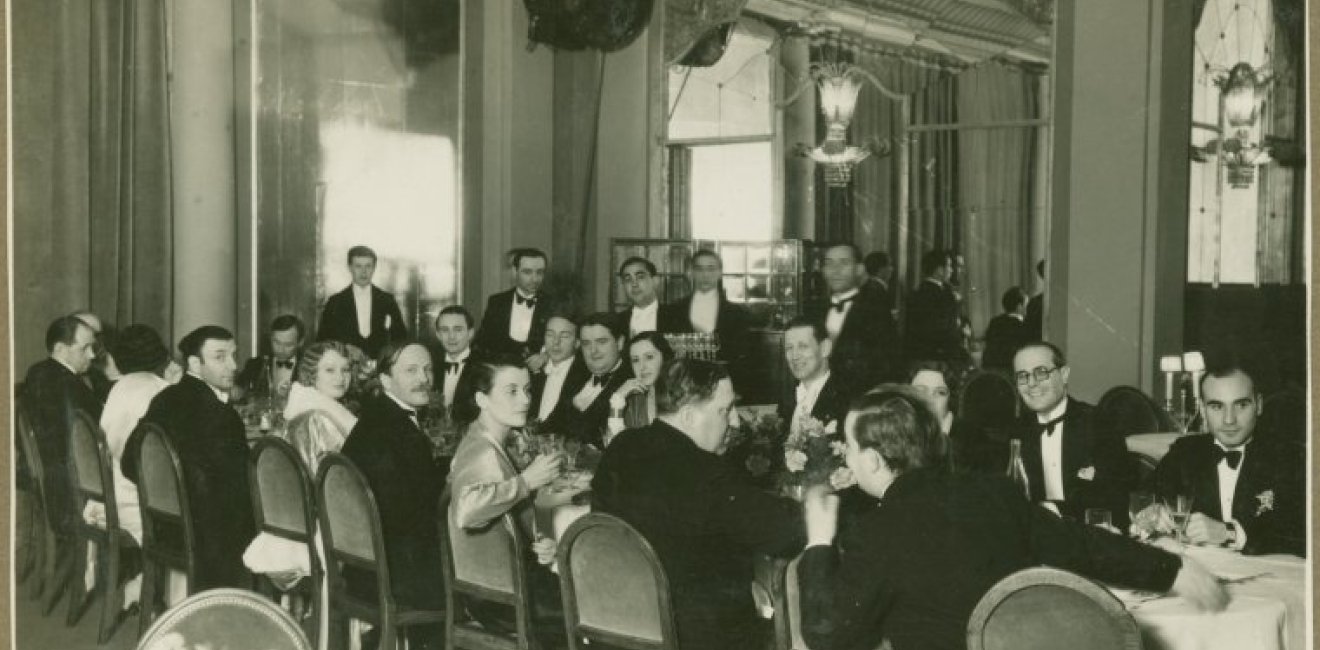
A blog of the Kennan Institute
BY NATALIE ROULAND
George Balanchine’s Easter Sunday suppers were legendary. White lilies, white candles, and white linens set the stage for his famous paskha, kulich, pirozhki, and sturgeon in aspic. At the height of his celebrity as co-founder of the New York City Ballet, Balanchine spent days in the kitchen of his West Sixty-seventh Street apartment preparing the traditional Russian Orthodox feast for guests, including his inner circle of Russian émigré artists and intellectuals, company members, and prominent New York physicians.
Onstage, Balanchine transported America to a world of movement and music that showcased the gems of the Russian imperial ballet tradition alongside the neoclassical abstraction of his “black and white” ballets. Offstage, Balanchine introduced the complex palate of Russian cuisine and the liturgical beauty of Orthodox customs into the lives of his American public.
A pioneering choreographer in an art form not often associated with haute cuisine, Balanchine stood out as a lover of good food, fine wines, and lavish entertaining. Invitations were coveted and rarely, if ever, refused. Former New York City Ballet principal dancer Edward Villella recalled yearning, in vain, for an invitation. In 1980 the “ballet superstar” and then-director of American Ballet Theatre, Mikhail Baryshnikov, even attended the Easter fête on the heels of his departure from Balanchine’s company.
Described by his first wife, the Russian dancer Tamara Geva, as “a mixture of poet and general,” Balanchine defied expectations and embodied dichotomies. A sensualist and a spiritualist, Balanchine was as much at home in the company studios on Madison Avenue, Broadway, and finally Lincoln Center as he was in the Russian Orthodox Cathedral of our Lady of the Sign on the Upper East Side, where Balanchine attended Easter services and where his 1983 requiem service was attended by over 1,000 mourners.
The same choreographic innovator who envisioned the long, lean ballet body immediately recognizable as the “Balanchine ballerina” relished serving up paskha, Russian Easter cheese cake made, according to his recipe, with ten pounds of tvorog, two pounds of butter, ten cups of sugar, and two dozen egg yolks. Balanchine inherited his love of cooking from his mother, Maria Vasilieva, a Russian woman of unknown origins who was not yet married to Balanchine’s father, Georgian composer Meliton Balanchivadze, at the time of his birth in 1904.
Balanchine’s Georgian relatives included the archbishop of Tbilisi, whose ritual conversion he witnessed as a child in St. Petersburg’s imposing Kazan Cathedral. According to scholar Elizabeth Kendall, Balanchine embraced the memory of his uncle, first prostrate on the stone floor and covered with a black cloth to symbolize his “worldly death,” then resurrected as a Russian Orthodox monk, as part of his “private mythology.” Dancers rising up in rebirth feature often in his oeuvre. And the very pyramidal structure of Balanchine’s annual paskha symbolized the tomb of Christ.
As he revealed to musicologist Solomon Volkov during a series of interviews in the 1980s, Balanchine associated “the pealing of the church bells on High Easter” with imperial St. Petersburg, the lost city of his childhood. Balanchine recalled standing for four hours at the Easter service of Vladimirskii Sobor, the church of Fyodor Dostoevsky, located near his Aunt Nadia’s apartment on Bolshaya Moskovskaya.
As a nine-year-old boarder at the Imperial Theatre School, Balanchine ran away to this very apartment, nestled in the shadow of the yellow and gold domes. Balanchine’s recollections of school vacillated between culinary pleasures—“the borscht was a work of genius”—and spartan punishment; the penalty for a poorly executed lesson entailed dinner without dessert.
Hunger defined Balanchine’s experiences during World War I and the Russian revolution. On the eve of their graduation from the Theatre School, Geva described Balanchine’s first choreographic forays: dances performed in exchange for rations such as flour and coffee, which they mixed together to make little cakes. Biographer Richard Buckle recounts Balanchine’s tales of surviving on pilfered fish and stray cats. And his second partner and schoolmate, Alexandra Danilova, suggested that the same deprivation that forced the boy Balanchine to steal from Red Army barges fomented the adult choreographer’s love of luxury and epicurean excess.
As a host and as a husband, Balanchine remained indefatigable. During Balanchine’s stint with the Ballets Russes in interwar Europe, Danilova recounted moveable feasts ranging from early days in Paris, where Balanchine sold his suit to procure a proper spread, to glamorous soirées in Monte Carlo, where Balanchine hosted dinners for the impresario Sergei Diaghilev.
Balanchine serendipitously met his second wife, the German dancer and actress Vera Zorina, at a Russian Easter celebration in New York in 1936. Balanchine courted her with five-pound caviar tins and vodka, and, on tour in 1939, prepared an entire Easter banquet in the kitchenette of their Chicago hotel. Zorina wrote in her memoirs, “I was as awed by his culinary talents (working in so cramped a space) as I was by his ability to choreograph under trying circumstances.”
Balanchine’s third wife, the American dancer Maria Tallchief, “the quintessential Balanchine ballerina of her day,” in the words of Villella, memorialized Balanchine’s equal passions for cooking and for composer Igor Stravinsky, with whom the couple often shared elaborate Christmas dinners.
Following Stravinsky’s death in 1971, Balanchine honored their career-spanning collaboration in a festival held during the week of the composer’s birth. On closing night, forty crates of vodka were distributed free of charge, and Balanchine gave a toast in which he reassured the audience that Stravinsky was not gone, but happily flying around the theatre.
Yet the solace that Balanchine offered to his fourth wife, the French ballerina Tanaquil Le Clercq, whose ascendant career abruptly ended after she contracted polio on the 1956 European tour, was cooking. Just as surely as he molded the bodies of his muses, Balanchine honed the culinary skills of Le Clercq, whose creative outlet, The Ballet Cook Book, preserved the foody anecdotes and recipes not only of Balanchine but also of the international ballet circuit.
Balanchine entered New York’s Roosevelt Hospital in November 1982 and passed his final days in the company of friends and food. Former principal dancer Jacques d’Amboise delivered borscht from the famed Russian Tea Room, Balanchine’s favorite nitery. Baryshnikov procured Georgian delicacies from a Brooklyn eatery. On his seventy-ninth birthday, Karol von Aroldingen, his last muse, cooked Balanchine’s beef kotletki with mushrooms and cream.
Balanchine died on April 30, just nine days before Russian Orthodox Easter. To the cherished members of his company, Balanchine bequeathed the royalties to the canonic ballets, which remain on the menu of the international repertory today. As Balanchine liked to say, “My ballet is like [a] great restaurant. I must prepare new, absolutely excellent food for our guests. Everybody is waiting.”
The opinions expressed in this article are those solely of the authors and do not reflect the views of the Kennan Institute.
Author

Scholar In Residence, The Washington Ballet

Kennan Institute
After more than 50 years as a vital part of the Wilson Center legacy, the Kennan Institute has become an independent think tank. You can find the current website for the Kennan Institute at kennaninstitute.org. Please look for future announcements about partnership activities between the Wilson Center and the Kennan Institute at Wilson Center Press Room. The Kennan Institute is the premier US center for advanced research on Eurasia and the oldest and largest regional program at the Woodrow Wilson International Center for Scholars. The Kennan Institute is committed to improving American understanding of Russia, Ukraine, Central Asia, the South Caucasus, and the surrounding region through research and exchange. Read more

Explore More in The Russia File
Browse The Russia File
Chechnya as a Model of Modern Russia

Russia’s Indigenous Communities and the War in Ukraine

Gas and Power in a Changing US–Russia Relationship

